How to Offer Feature Voting to Your Users (+ 10 Tools)

By Dayana Mayfield
Last updated on Tue Mar 11 2025
Imagine launching a new feature, only to find out it’s not what your users actually wanted. Twitter famously avoided this mistake by running a simple feature vote—when Elon Musk asked users if they wanted an edit button, over 70% of 4 million respondents said yes. This kind of direct user input is exactly why feature voting is essential for SaaS companies.
Feature voting allows your customers to upvote feature ideas, helping product teams prioritize what matters most. Instead of relying solely on gut instinct or scattered feedback, feature voting provides a clear, data-backed way to shape your roadmap.
In this guide, we’ll dive into:
Why letting users vote for ideas is so powerful when prioritizing customer feedback as a SaaS business
The best ways to implement it (and common mistakes to avoid)
The top tools to streamline the process
If you’re struggling with feature prioritization, feature voting could be the missing piece to make your product decisions more customer-driven and impactful. Let’s get started.
Why you should offer feature voting to your users
Here’s what Frill’s own idea board and public roadmap looks like. Some of our features have upwards of 70 upvotes on them, cueing our team into the fact that the request is popular.
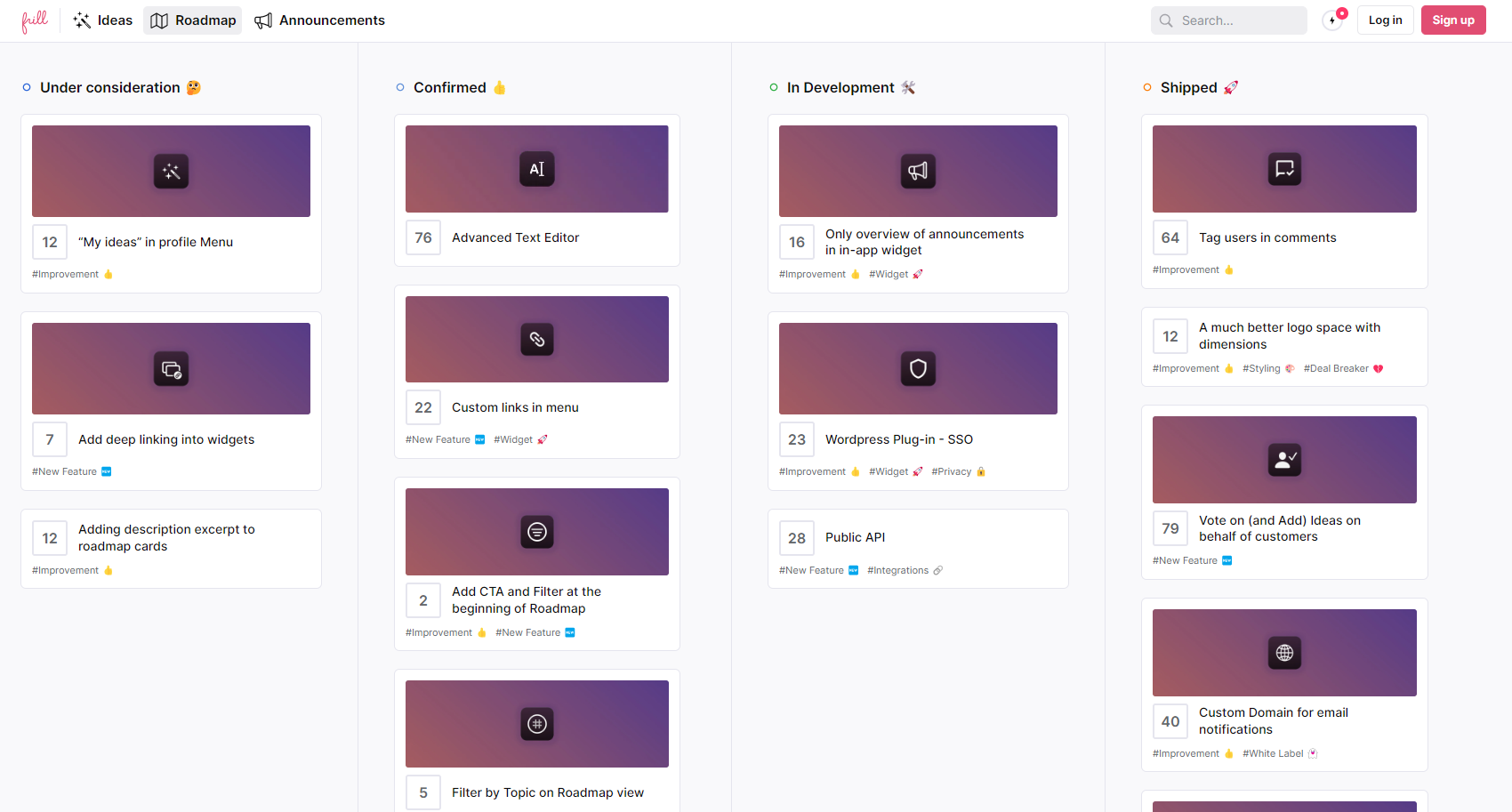
Feature voting offers a lot of benefits for SaaS product managers. Here are the top ones:
Interactive - Feature voting offers a way for users to interact directly with your product team, instead of just your marketing, sales, and customer service team. Engaged users are more likely to stick around, and every bit of interaction counts.
Quick and easy for users - It’s super easy for users to hit that upvote button. They don’t have to write a comment or submit their own idea. They can just see an idea they like and upvote it. This is an instant way for them to give feedback. If you use a tool like Frill that offers SSO for users, they’ll be automatically logged into the idea board when they’re signed into their account.
Faster prioritization for you - Not sure what feature request to add into your next sprint? A quick glance at your idea board will show you which features have been upvoted the most.
Helps you build a better product - Ultimately, customer feedback is all about helping you get as close to your customers as possible so you can build the product they want. Feature upvoting might seem like a small thing, but it has a big impact.
3 ways to offer feature voting
While customer feedback software is certainly the best way for companies to offer feature voting, it’s not the only way. Companies can also use project management Kanban boards or even polls.
Here are the top three ways to collect votes on new potential features from your users.
1. Customer feedback tools
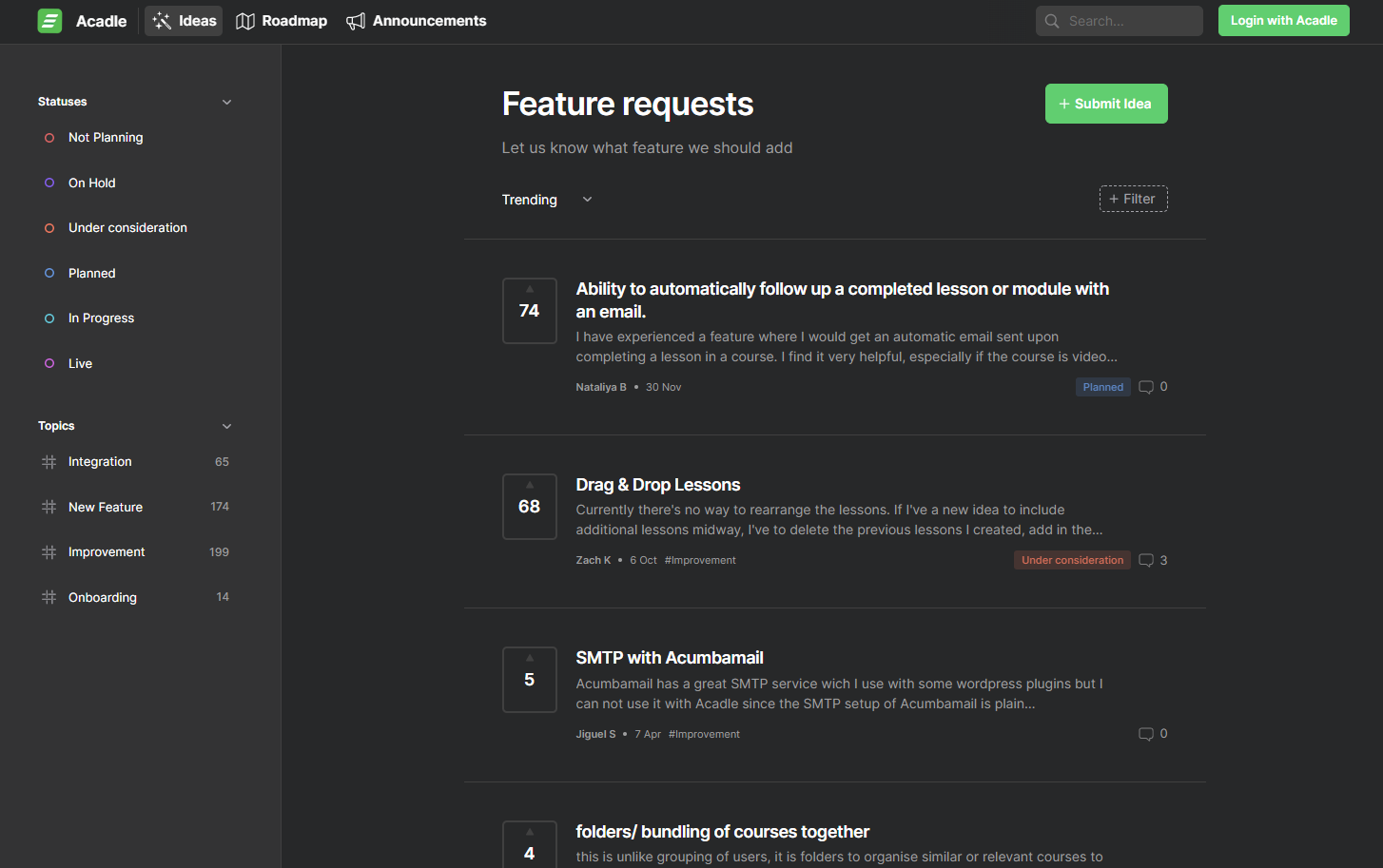
A great customer feedback tool should make it easy for users to add new ideas and vote on existing ideas. You can make this public to everyone, or require users to sign in with SSO in order to see it.
Pros:
Exclusively designed for collecting user feedback
Should have upvoting built in
Comes with other cool features like an in-app widget, a public roadmap, and release notes
SSO with the credentials they use for your product
Cons:
Unless you have a small user base, you will need to pay for the tool, but it should be affordable (with Frill, for example, you can get unlimited ideas for $49 per month)
2. Trello or other project management tools

You can also use Trello. Here’s an example feature request board built with Trello from Sociamonials. But as you can see, it’s kind of a mess.
Pros:
Consolidate your tool budget (you can use the project management tool you’re already paying for)
Cons:
Users have to have an account with that project management tool in order to upvote something
People can add ideas and upvote your features even if they’re not a user (because the tool doesn’t offer SSO connected to your product)
Lack of privacy for users who vote on features (their full names are shown)
Ugly UX and ideas can be difficult to read because of all the clutter
3. Surveys and polls
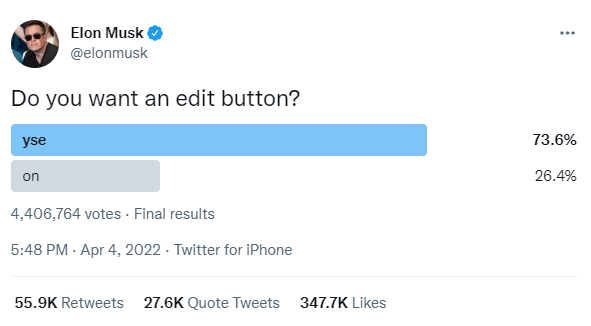
Ah, the feature request heard around the world, Elon’s edit button poll. Pointless news items aside, this is neither the best nor the worst way to source feedback from your audience.
You can use a survey or a poll to ask for your audience’s approval of a certain feature idea.
A designated feedback tool will give you better results because you can collect open-ended feedback from your audience. But there are different types of feedback.
A survey or poll could be a good fit for gathering feedback on a big product decision or direction for your product.
Pros:
Can fetch a high number of responses
Can be used to get feedback from a particular segment (when you email your survey to a subset of users)
Cons:
Doesn’t allow for open-ended feedback
Has to be implemented every time (someone has to actually create the poll or send the email)
10 feature voting tools built for SaaS companies
Let’s assume that you want to use a feature voting tool that’s truly designed for the job--and just say no to messy Trello boards.
Here are the top seven feature upvoting tools, complete with up-to-date pricing information.
1. Frill
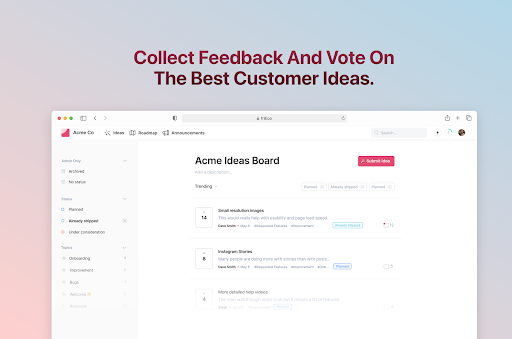
Frill is a customer feedback tool that includes an idea board, product roadmap, and announcements all in one place so you can collect feedback from users, add it to your roadmap, and then publish release notes.
You can set up your roadmap in a Kanban-style board, and create you own columns/tags. Popular options include: under consideration, upcoming, building, and launched.
Pricing:
The lowest priced plan is $25 per month, and you get up to 50 active ideas at a time. The Business plan offers unlimited ideas for $49 per month. For both unlimited ideas and white labelling, you can choose the Growth plan which is $149 per month.
Get started with a free trial of Frill.
2. Acute
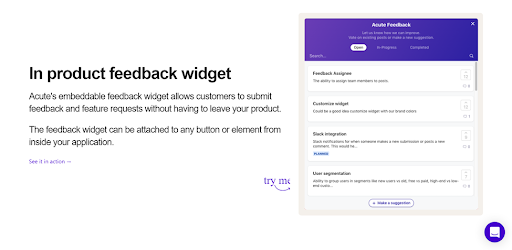
Acute is a customer feedback tool that offers easy-to-customize widgets that you can embed in your website and product. You can synch the tool with user data to discover things like their signup date and MRR. And of course, feature voting is included, so that users can upvote existing feature ideas from other users. Unlike Frill, Acute doesn’t offer a feature for release notes.
Pricing:
Acute’s Enterprise plan is $99 per month for unlimited feature suggestions. The Growth plan costs just $25 per month and covers up to 1000 suggestions. You can also try their free plan, which allows up to 20 suggestions.
3. Savio
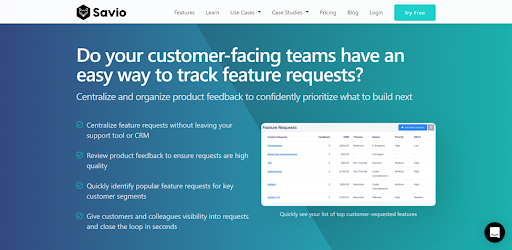
Savio is a tool for collecting and tracking feature requests. The top feature is the ability to centralize product feedback from multiple sources, such as Zendesk, Intercom, Help Scout, Slack and other sources. You can also prioritize features through some useful integrations, such as checking for requests from top-paying customers in Hubspot. There is a featuring voting board for users as well.
Pricing:
Savio offers an Essential plan for $39 per month, which offers one roadmap and feature voting board. The Professional plan costs $79 per month and offers up to 5 roadmaps.
4. Sleekplan
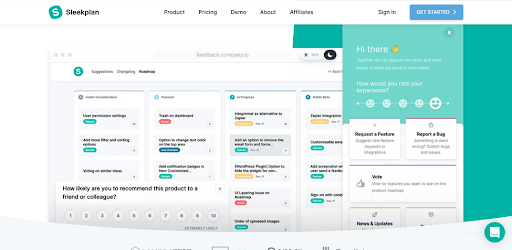
Sleekplan is a user feedback tool that SaaS product managers can use to manage their feedback board, feature voting, public roadmap, and changelog. The tool also includes customer satisfaction ratings (CSAT) and net promoter score (NPS) surveys.
Pricing:
The Business plan costs $45 per month. If you need more team seats, you can contact sales for a custom quote for an Enterprise plan.
5. Rapidr
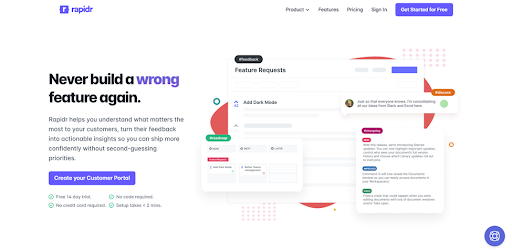
With Rapidr, you can manage feature requests and bugs. The top features include the feature suggestion and upvoting board, bug tracking, and release notes. The bug tracking feature works as a product widget for users to submit an issue with a description and screenshot. They can submit an issue or an idea, based on the type of feedback they’d like to offer.
Pricing:
With the Startup plan, you'll pay $49 per month and get up to 5 team members. With the Business plan, you'll pay $199 per month for up to 50 team members.
6. Nolt
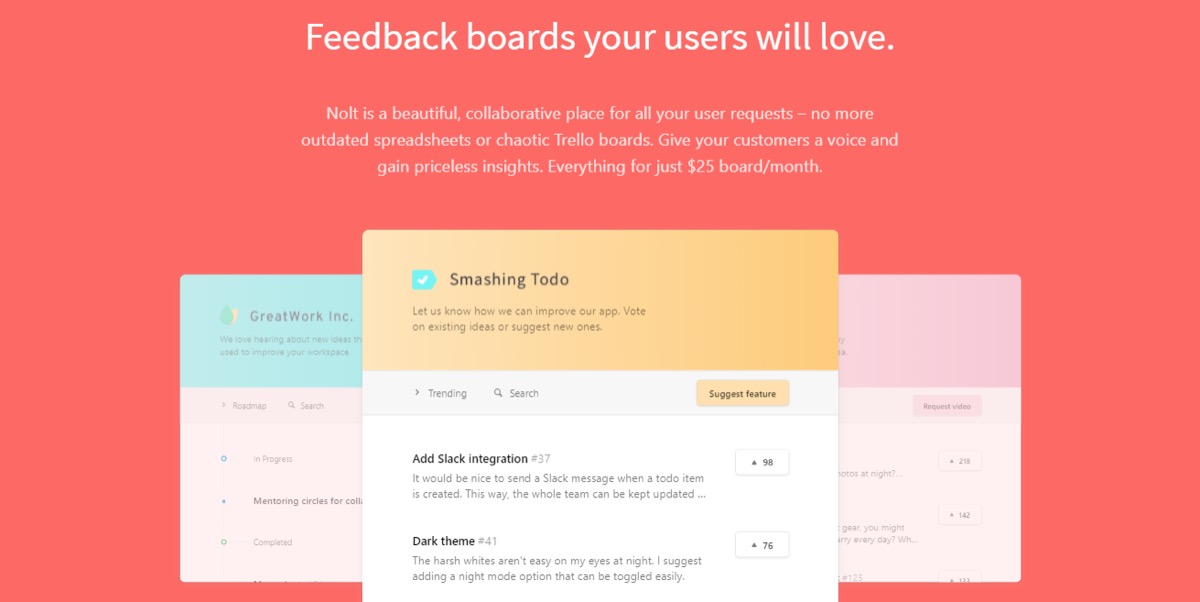
Nolt offers product feedback boards, public roadmaps, feature voting, custom branding, and single sign-on to make it easy for your users to interact with the boards.
Pricing:
The Essential plan covers one idea board for $29 per month, while the Pro plan offers 5 boards and important integrations for $69 per month.
7. FeatureOS
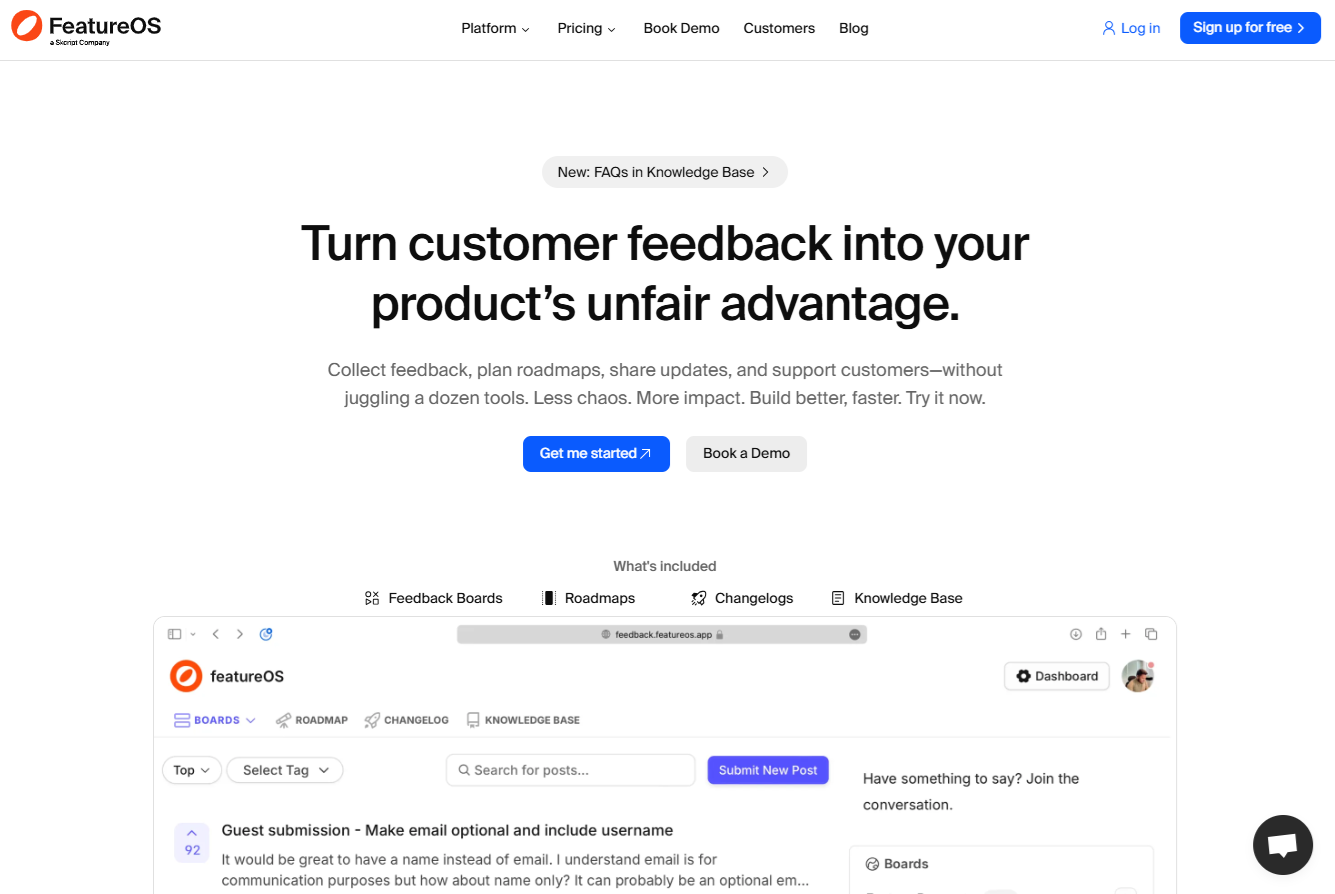
FeatureOS is a product lifecycle management platform that streamlines feedback collection, roadmapping, and changelog updates. It enables teams to gather user insights through feature upvoting, prioritize development, and communicate progress effectively. With feedback boards, customizable roadmaps, and an integrated knowledge base, FeatureOS helps product teams stay aligned with user needs. Its automation and AI-powered tools enhance workflow efficiency, making it a comprehensive solution for managing product development and customer engagement.
Pricing:
The Starter plan costs $60 per month for 5 feedback boards. The Growth plan costs $120 per month and gives you 10 feedback boards. For unlimited boards and integrations, consider the Business plan, which costs $250 per month.
8. Noora
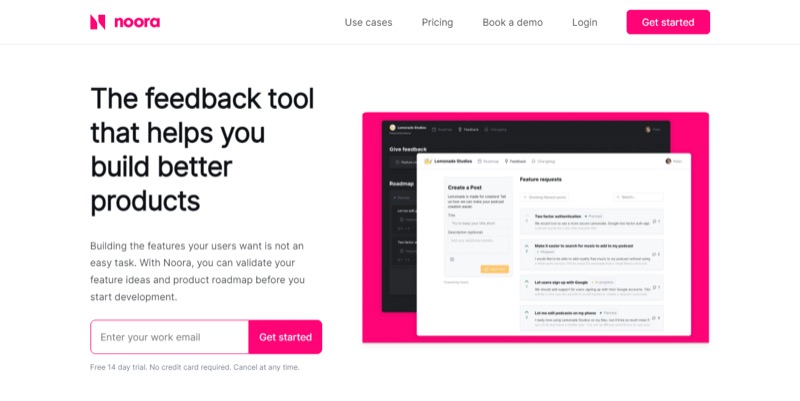
Noora is a feature upvoting tool that helps teams collect, prioritize, and act on user feedback. It allows customers to vote on feature requests, ensuring product teams focus on what truly matters. With a public roadmap, automated changelog updates, and integrations with Jira, Slack, and Intercom, Noora streamlines the feedback loop. Enhance engagement, reduce churn, and build better products by making data-driven decisions with Noora.
Pricing:
The Startup plan costs $14 per month, the Growth plan costs $29 per month, and the Enterprise plan costs $64 per month. Higher-tier plans offer SSO, integrations, and better customization.
9. Canny
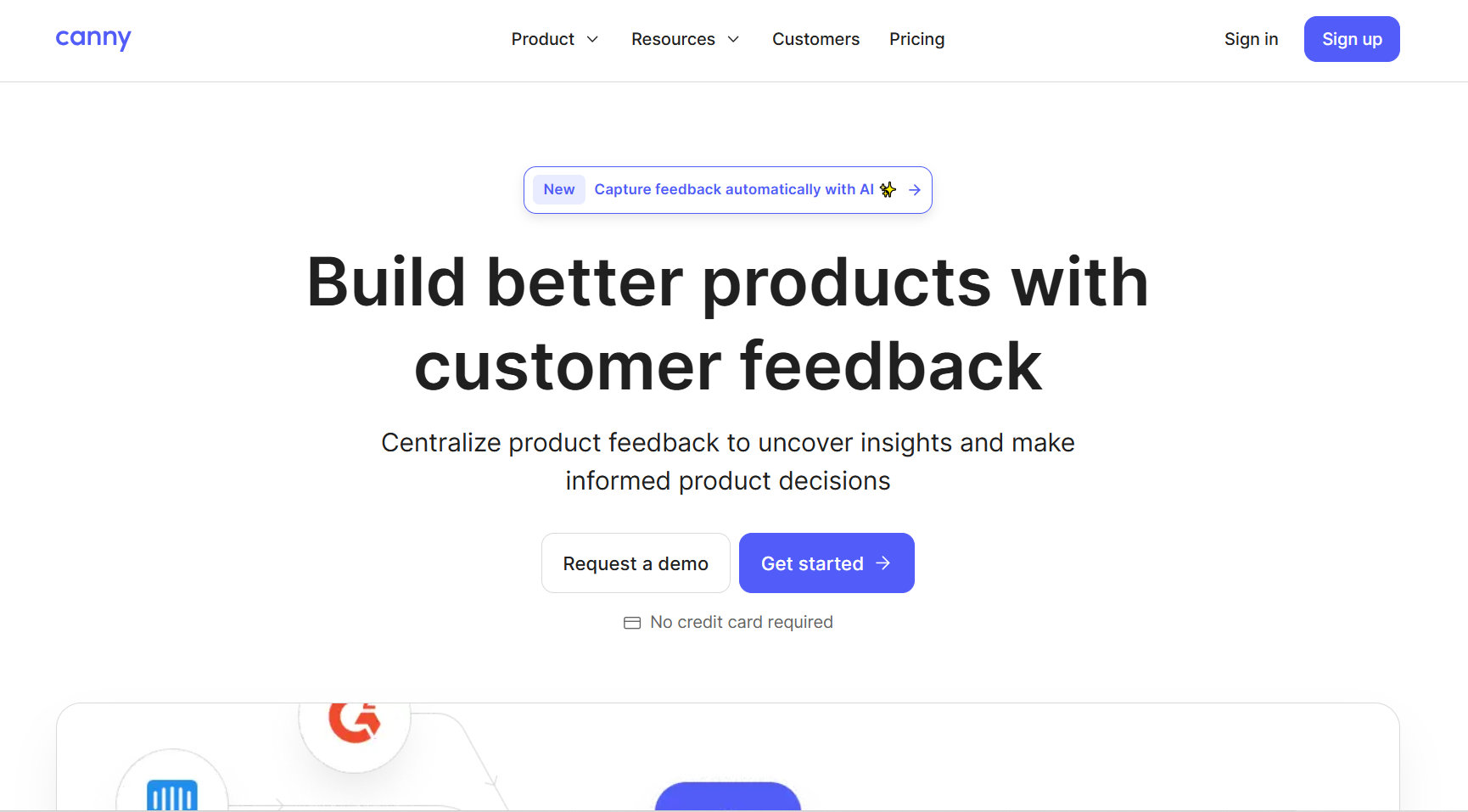
Canny is a customer feedback management platform that helps teams collect, prioritize, and act on feature requests. With feature voting, users can upvote ideas, making it easy to identify the most in-demand features. Canny integrates with popular tools like Intercom, Slack, and Jira, enabling seamless feedback collection and collaboration. Close the feedback loop and build better products with Canny’s AI-powered automation and intuitive workflows.
Pricing:
The Starter plan costs $79 per month and offers unlimited posts and a custom domain. The Growth plan costs $359 per month and also gives unlimited integrations and advanced AI features.
10. Aha! Ideas
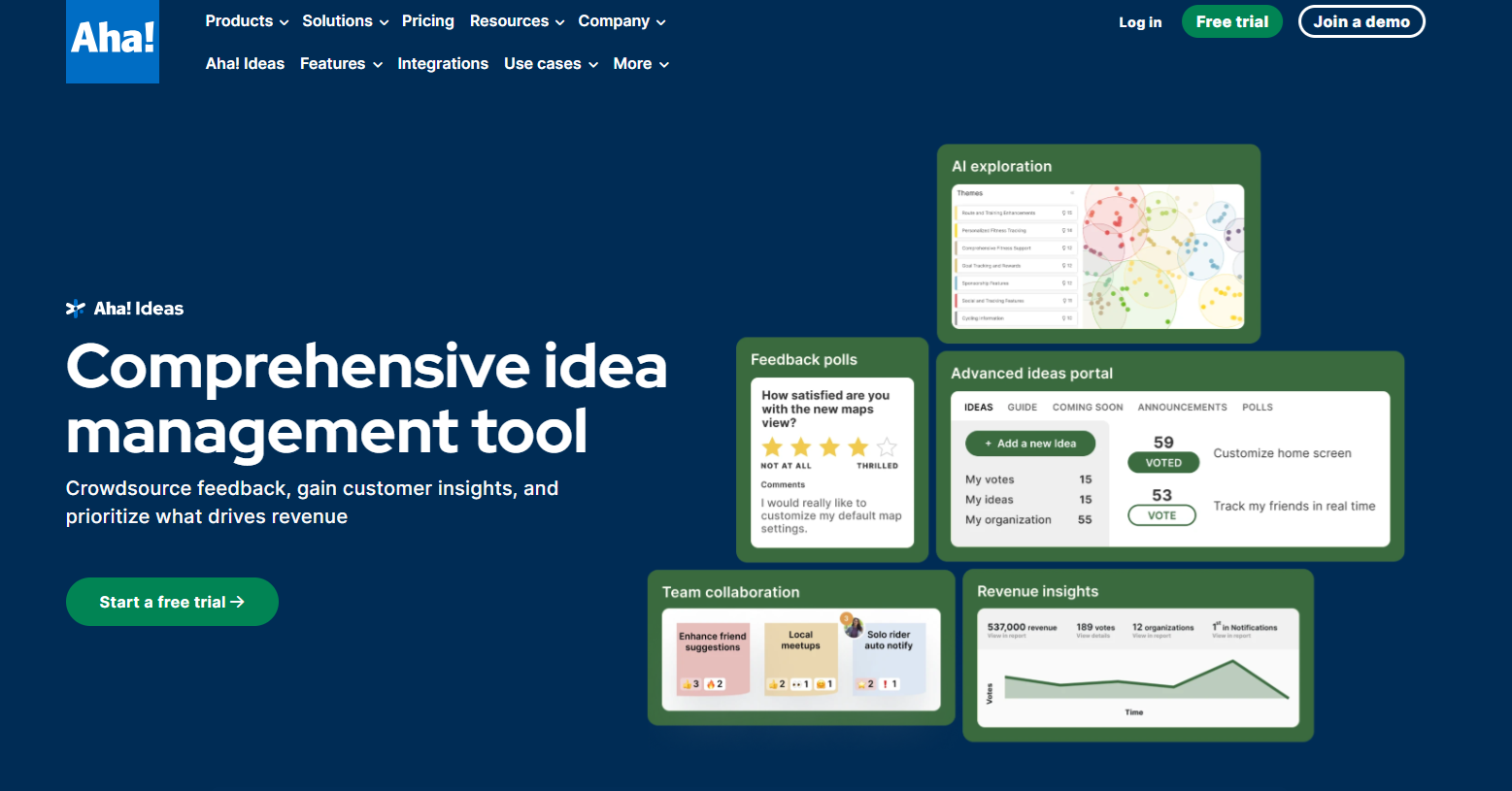
Aha! Ideas is a comprehensive idea management tool that helps product teams centralize feedback, engage users, and prioritize impactful features. With built-in feature voting, customers can upvote ideas, making it easy to track demand. AI-powered analytics, scorecards, and Salesforce integration help teams make data-driven decisions. Empower your users while aligning feedback with business goals—streamline your product planning with Aha! Ideas.
Pricing:
The Essentials plan costs $39 per month and includes idea boards and feature voting. The Advanced plan costs $59 per month and adds in feedback polls, widgets, and important integrations.
How to not over-rely on feature voting
Feature upvoting is a valuable tool, but it shouldn't be the only factor guiding your product roadmap. While it helps surface popular ideas, relying on upvotes alone can lead to short-sighted decisions that don’t align with your long-term product vision or business goals.
Here’s how to balance feature voting with other critical decision-making factors:
1. Prioritize the requests of your best customers
Not all upvotes are created equal. A feature that’s popular among free users might not be as valuable as one requested by your highest-paying customers. Consider:
Segmenting upvotes by customer tier (e.g., enterprise users vs. free-tier users).
Weighing feedback from power users—those who rely on your product the most.
2. Align with your product vision
Just because a feature gets a lot of votes doesn’t mean it belongs in your product. Every SaaS company should have a clear product vision—one that guides innovation rather than just responding to demand. Before implementing a highly upvoted request, ask:
Does this feature fit within our long-term strategy?
Will it help us differentiate from competitors?
Does it align with our brand and user experience philosophy?
3. Consider feasibility & technical effort
Some of the most upvoted features may be incredibly complex or resource-intensive to build. Product teams must evaluate:
Development effort—How much time and engineering power will this require?
Potential trade-offs—What features might get delayed if we prioritize this?
Security & scalability concerns—Will this feature introduce risks or make maintenance harder?
4. Factor in market demand & competitive advantage
A feature might be popular with your existing users, but does it help attract new customers or improve retention? Market research can help you assess:
Competitor offerings—Are competitors offering this feature, and does it give them an edge?
Industry trends—Is this a growing demand or just a temporary request?
Customer acquisition impact—Could this feature help expand into new markets?
5. Weigh Revenue Potential & Business Impact
Some features drive revenue more than others. Instead of blindly following upvotes, analyze:
Will this feature increase conversions or retention?
Can it justify a higher pricing tier or expansion revenue?
Will it attract ideal customers or just add complexity for little gain?
While feature voting is an essential input, the best product teams use it alongside other decision-making criteria. Balance upvotes with strategic vision, customer segmentation, feasibility, and business impact to make smarter, high-impact product decisions.
Looking for a beautiful feedback tool with UX that you and your users will love? Then check out Frill.